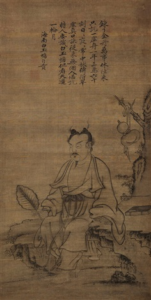Daoism Series 19
谷神
The Valley Spirit [excerpt]
___________________________________________________________

An interesting account of the Valley Spirit is found in Bai Yu Chan’s [白玉蟾] [1] ‘Discussions of the Valley Spirit That Never Dies’ [gu shen bu si lun谷神不死论], a chapter in The Ten Books on Cultivating the Truth: Treatise on the Miscellaneous Writings Pointing to the Mysterious [xiu zhen shi shu za zhu zhi xuan pian 修真十书杂著指玄篇], published ca. 1225. It explains at length a crucial sentence in chapter 6 of the Dao De Jing; ‘The valley spirit never dies’ and exemplifies why the Dao De Jing is the second most translated book after the bible, as its layers of meaning seem unfathomable:.
谷者,天谷也。神者,一身之元神也。天之谷含造化,容虚空,地之谷容万物,载山川。人与天地同所禀也,亦有谷焉。其谷藏真一、宅元神,
The valley is the heavenly valley. The spirit is the original spirit of the entire body. The heavenly valley holds creation and transformation, and it contains the void and emptiness, while the earthly valley contains the ten thousand things and holds the mountains and rivers. This is what humans, heaven and earth are equally endowed with, and they all possess the valley. This valley stores the true oneness and houses the original spirit.
是以头有九宫,上应九天。中问一宫,谓之泥丸。又曰黄庭,又名昆仑,又名天谷,其名颇多。乃元神所住之宫,其空如谷,而神居之,故谓之谷神。
Therefore, the head has nine palaces, corresponding to the nine heavens above. The central palace is called the Mud Pill. It is also called the Yellow Court, and is known by the names of Kun Lun and Heavenly Valley, too. It has quite a number of names. Thus, it is the palace which the original spirit inhabits. As its emptiness is like that of a valley, the spirit resides there, therefore i is called the Valley Spirit.
神存则生,神去则死,日则接于物,夜则接于梦。神不能安其居也,黄粮未熟,南柯未寤,一生之荣辱富贵,百岁之悲忧悦乐备尝于一梦之问,使其去而不还,游而不返,则生死路隔,幽明之途绝矣。
When the spirit exists, there is life. When the spirit departs, there is death. During the day it comes into contact with things; at night it comes into contact with dreams; it is unable to reside in peace. Before the yellow millet has finished cooking, before waking from the kingdom of Nan Ke, a lifetime of honour and disgrace, wealth and position, a hundred years of sorrow, worry, joy and delight, all tasted within one dream. Drawing out the spirit to wander, one is unable to return. This is where the road to life and the road to death part ways, and the path between darkness and light is cut off.
由是观之,人不能自生而神生之,人不能自死而神死之。若神居其谷而不死,人安得而死乎?然谷神所以不死者,由玄牝也。元者,阳也,天也。牝者,阴也,地也。然则玄牝二气各有深旨,非遇至人授以口诀,不可得而知也。
Following this observation, people are unable to be born, as the spirit gives birth to them. People are unable to die by themselves, as the spirit lets them die. If the spirit resides in this valley and becomes non-dying, then how could it be the person die? Nevertheless, the reason that the valley spirit is non-dying rests with the mysterious female. The ‘original’ is Yang and the heavens. The ‘female’ is Yin and earth. That being the case, the mysterious female is two [types of] Qi, each possessing deep meaning. If one does not encounter a person of attainment to instruct one by oral transmission, one will be unable to obtain this knowledge.
《灵枢内经》日:天谷元神,守之自真。言人身中,上有天谷泥丸,藏神之府也;中有应谷绛宫,藏气之府也;下有灵谷关元,藏精之府也。天谷,元宫也,乃元神之室,灵性之所存,是神之要也。圣人则天地之要,知变化之源,神守于元宫,气腾于牝府,神气交感,自然成真,与道为一,而入于不死不生。
In the Spiritual Pivot of the Internal Classic, it is stated: the heavenly valley is the original spirit, which is safeguarding one’s own truth. From the perspective of the human body: above, there is the heavenly valley – the Mud Pill, the residence that stores the spirit; in the centre there is the resonant valley – the Purple-Red Palace, the residence which stores the Qi; below there is the divine valley – the Gate of Origin, the residence that stores the essence. The heavenly valley is the original palace, thus it is the chamber of the original spirit, where the divine inner nature is preserved, therefore, it is a crucial [location] of the spirit. The sages then [understand] the essentials of the heavens and earth, and know the sources of transformation and transmutation. Their spirit is preserved in the original palace. while Qi soars within the female residence. As their spirit and Qi intermingle in affection, they naturally become the truth. Together with the Dao they become oneness, and furthermore enter [into a state] of non-dying and non-birth.
[1] Bai Yu Chan (1194–1229?) was a famous Daoist and one of the Founding Ancestors of the Southern Lineage of the Golden Elixir Sect.
___________________________________________________________
Post-Scriptum: This article will be published in full as part of a book, entitled ‘Arts of Daoism’ about meditation, stillness cultivation, abstention from grains [bi gu辟谷], sleeping gong [shui gong睡功], dreams, vegetarianism and diet in Daoism, formulae for fasting and meditation incense, including several chapters from the alchemical classic The Essentials of the Shortcut to the Great Achievement [da cheng jie yao 大成捷要]. It will be a mixture of anecdotal and oral transmissions from my teacher Li Shi Fu and translations of a number of chapters from ancient texts. It is set to be released before Christmas 2020, and a first draft is already finalized.
